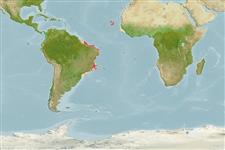Generally a plankton-eater. Found on deep reefs (40-60 m), where it is recorded inside the lumen of tubular sponges (Ref. 39606). At Fernando de Noronha and Trindade Islands, groups of 10-450 initial-phase individuals clean other fishes in the water column close to the reef bottom and pinnacles (Ref. 36301, 49354). Also at Fernando de Noronha Archipelago, juveniles follow foraging green turtles (Chelonia mydas) and pick off particles stirred from the bottom by the turtle’s activity (Ref. 51385). Fish clients include about 20 species of surgeonfishes, damselfishes, parrotfishes, grunts, and even small groupers such as coneys. Occasionally, a coney (Cephalopholis fulva) preys on isolated Noronha wrasses out and away from the cleaning stations. Coastal individuals were never recorded cleaning. Strictly diurnal, this wrasse is one of the last reef fishes to emerge from nocturnal shelters and one of the first to retreat (Ref. 36301). Initial-phase individuals are predominantly dark-brown and white, whereas terminal-phase males are blue and purple. A group-spawner throughout the year, adult females form harems dominated by a few terminal-phase males. Pair spawning is also recorded for this wrasse (Ref. 49354). Traded as an aquarium fish at Ceará, Brazil (Ref. 49392).
通常一個吃浮游生物者。 棲息於深的礁 (40-60 公尺)了, 在那裡它在管海綿的內腔裡被記錄.(參考文獻 39606) 在 Fernando de Noronha 與 Trindade 島, 群體的 10-450個起始階段的個體在水團清理其他的魚接近礁石底部與峰頂.(參考文獻 36301,49354) 也在 Fernando de Noronha 列島,稚魚跟隨覓食綠海龜 ( Chelonia mydas) 而且剔啄被從底部激起藉由海龜的活動的外海的粒子。 (參考文獻 51385) 魚客戶包括大約刺尾魚,雀鯛,鸚哥魚,咕嚕咕嚕聲的 20個種, 甚至小的鱸科魚類例如 coneys。 偶然地, coney( 金黃九棘鱸〔Cephalopholis fulva〕 ) 捕食在外的孤立 Noronha 隆頭魚科的魚而且遠離清潔的區域。 海岸的個體從不被記錄清潔。 嚴格日行性, 這一個隆頭魚是從夜行的庇護所與第一個之一浮現撤退的最後珊瑚礁魚類之一.(參考文獻 36301) 起始階段的個體是主要深褐色而白色的,然而最後階段雄性是藍色與紫色的。 一個群-產卵魚全年度,雌性成魚形成被一些最後階段雄性控制的雌性配偶群。 成對產卵也為這一個隆頭魚被記錄。 (參考文獻 49354) 在巴西的塞阿臘作為一個水族館魚交易了。 (參考文獻 49392)
Preferred temperature (Ref.
115969): 23.8 - 27.6, mean 27 (based on 184 cells).
Phylogenetic diversity index (Ref.
82804): PD
50 = 0.5000 [Uniqueness, from 0.5 = low to 2.0 = high].
Bayesian length-weight: a=0.00646 (0.00315 - 0.01323), b=3.13 (2.95 - 3.31), in cm Total Length, based on LWR estimates for this species & (Sub)family-body (Ref.
93245).
營養階層 (Ref.
69278): 3.4 ±0.4 se; based on size and trophs of closest relatives
回復力 (Ref.
120179): 高度, 族群倍增時間少於 15個月 (Preliminary K or Fecundity.).
Fishing Vulnerability (Ref.
59153): Low vulnerability (10 of 100).
